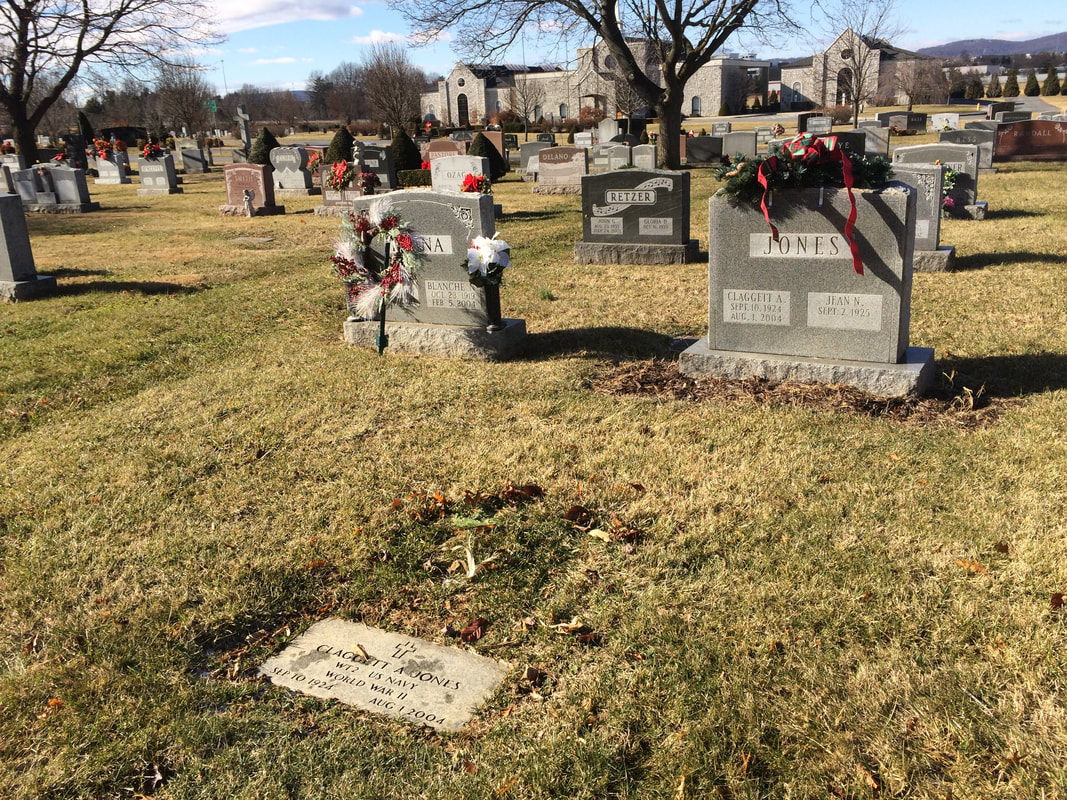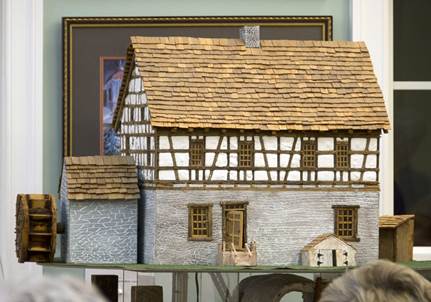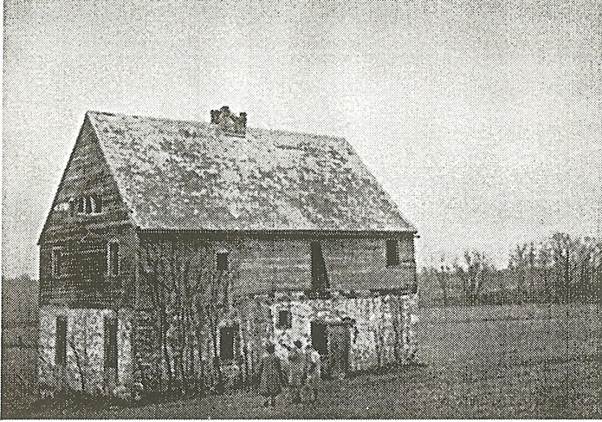|
People often ask me what is the oldest burial stone marker in Mount Olivet Cemetery? It’s a great question, but one whose answer is not rooted in the cemetery’s first interment of 1854, or the cemetery's first monument. Ironically, it has a direct connection with the word stone, itself, not to mention being that of the builder of Frederick’s oldest known house. If you guessed the Brunner family (Schifferstadt built ca. 1758), you’d be wrong. It’s the gravestone, or grabstein, of Jacob Steiner (1713-1748). And in case you didn’t take German in high school, “stein” is the German word for stone. To understand the significance of this unique cemetery marker, one can also look at the significance of the house Jacob Steiner left behind, the archaic centerpiece of one of Frederick’s prime residential developments. Both are true stories left in stone. Master of Mill Pond I was intrigued to see a recent story in the Frederick News announcing the formation of the Mill Pond House Ruins Committee, a group taking aim to further preserve and interpret the “mortal remains” of what most likely represents Frederick’s oldest known house. The article states that City of Frederick planning officials are aiming to take the ruins over as part of a parkland dedication agreement with the developers of Worman’s Mill, located in the northeast portion of the city, just off MD route 26 and Monocacy Boulevard. Thankfully the remnants were not bulldozed with the creation of the Worman’s Mill community a few decades back. You can find them safely secured behind a chain link fence, located off a bicycle/walking trail that traverses the Worman’s Mill Conservancy property. This locale is bounded by Tuscarora Creek and Mill Race Road, and is also in close proximity to the Monocacy River to the northeast.  Dedra Salatrik with the ruins in the background (photo courtesy of the Frederick News-Post) Dedra Salatrik with the ruins in the background (photo courtesy of the Frederick News-Post) Unfortunately, all that exists of the original Mill Pond House are the chimney and a few of the structure’s stone walls. The current location of the remains of the Mill Pond House can be found on the Worman’s Mill Conservancy property (abutting the fore mentioned Mill Race Road and the Tuscarora Creek). We are lucky that multiple residents, past and present, have taken a great interest in the architectural importance of the house, and the life of its original builder. Neighboring Worman’s Mill resident Dedra Salitrik, a master gardener, became enamored with the Mill Pond House when she and husband, John, bought their home on Mill Race Road. The Salitrik residence actually backs to the ruins, and gave inspiration for their purchase at this location. The couple immediately started doing detective work on the structure, eventually receiving permission from the Wormald Development Company to go inside the chain-link fence and build a pollinator garden to attract birds and bees. They went on to enhance the ruins with plantings of elderberries, winterberry holly, milkweed and turtlehead. As for context on this old house, Worman’s Mill resident and historian Heidi Sproat wrote the following introductory piece on the Worman Mill Conservancy’s website: Jacob Stoner, a German settler to Frederick, MD built the Mill Pond House around 1746, before the Revolutionary War, on a site along the Old Annapolis Road. It was a prime example of half-timber and wattle-and-daub construction typical of late medieval dwellings in the valley of the Upper Rhine in Germany. In fact, it was the only known house in the East German or Palatine style ever built in Maryland. The house was constructed entirely of peg and rail construction; there were no nails used. The house was built forty feet wide and thirty feet deep and had two stories. While the original house was constructed using a technique known as "waddle and daubing," the ground floor was made of both sandstone and limestone. Incredibly, there was a vaulted cellar and spiral stairs. The house resembled what we refer to today as English Tudor. After Jacob Steiner’s (Stoner’s) death in 1748, the Mill Pond House, and surrounding property, was held by the Frederick County court and eventually transferred to his children in 1767. His wife had died the same year, leaving minor aged children. Jacob’s eldest son, John, inherited the Mill Pond parcel and continued to operate his father’s mill. Mill Pond was sold out of the family in 1798 (the time of John’s death) to William Potts, who would eventually convey the property to namesake Moses Worman on April 3, 1811. I have had the pleasure of knowing two of the leading contemporary authorities on Jacob Stoner and his Mill Pond House. One is my friend Patricia “Pat” Ogden, a historian, genealogist and master docent at Schifferstadt Architectural Museum. Pat has researched and presented on the Mill Pond House and Jacob Steiner in recent years, and serves as a key member of the Mill Pond House Ruins Committee. The other individual of note is no longer with us, however my work office is within 100 yards of his gravesite. His name was Claggett Jones (1924-2004). Claggett Jones, a Washington DC native and World War II veteran, took a great interest in the Mill Pond House and its history. After his retirement from the Department of Commerce, Mr. Jones moved to Frederick with his wife Jean, taking up residence in the Worman’s Mill community. Back in 1995, he was kind enough to provide me with a copy of an old article from 1951 which included photographs of the ancient structure for use in my documentary film series Frederick Town. A few years later, we invited Claggett to be a guest for a special feature on Young at Heart, one of our GS Communication’s Cable 10 television programs. He spoke on the Mill Pond House and shared a spectacular two-foot square model of the structure which he and lifelong friend and neighbor Wes Stewart had meticulously crafted in his basement. Jacob Steiner (Stoner) One of the area’s earliest settlers, Jacob Steiner (Stoner), was one of six men who tried to buy Tasker’s Chance in the late 1730’s. Tasker’s Chance was a parcel of 7,000 acres patented to Annapolis businessman and politician Benjamin Tasker in June 1727. It was eventually conveyed to Frederick Town’s founder, Daniel Dulany, and would constitute the bulk of the land that the City of Frederick sits on today. Of the 19 individuals in 1746 who initially received deeds from Dulany, only Steiner received more than one parcel. He held three lots, all located northeast of the newly laid-out town. Steiner operated a grain mill near the mouth of the Tuscarora Creek and named his lands Bear Den, The Barrens, and Mill Pond. It was on this latter tract that Jacob Steiner erected a late medieval-style stone and timber dwelling in 1746. Not much more is documented about Jacob Steiner’s arrival to this country from Germany, or his early years here. He was born in 1713 and married Magdalena Glattacker (1715-1748) in 1733. It is likely that Jacob arrived in Philadelphia and settled west of the city like many of his German brethren of the era. He would eventually come to Maryland and the Monocacy River Valley in the late 1730’s. In the year 1740, Jacob Steiner was naturalized with sons John and Jacob (Jr).  Trinity Chapel (ca. 1950) Trinity Chapel (ca. 1950) Jacob Steiner would not see the growth of Frederick, dying in 1748 at the age of 35. He would be laid to rest in the first graveyard associated with the German Reformed Church. This was located behind the site of the congregation’s first church structure in the first block of West Church Street. The place of worship would eventually be enhanced in the form of Trinity Chapel which still exists today. The burying ground stretched from behind the church, southward to West Patrick Street. The former McCrory's Store, today’s Maryland Ensemble Theater building (31 W. Patrick St.), occupies the footprint today. The congregation eventually built a second graveyard at the corner of Bentz and West Second streets, the site of Memorial Park. With the opening of Mount Olivet in 1854, many churches were relieved of the burden of not having adequate burial space. In some cases, folks bought lots in Mount Olivet and decided to move their ancestors into newly purchased lots from other cemeteries. Sometimes this was by choice, and other times by necessity as various congregations were making decisions to expand church structures, build support buildings or simply sell off downtown graveyard properties for lucrative offers made for residential and commercial purposes. This was the situation with for the German Reformed Church’s first cemetery. Coincidentally, the church’s second cemetery, original resting place of the famed Barbara Fritchie, was condemned by the City of Frederick in the 1920’s, and repurposed as Memorial Park in which soon became home to a fine World War I monument, erected in 1924.
 Replacement memorial stone for Jacob Steiner Replacement memorial stone for Jacob Steiner Our cemetery records do not show the removal or reburial of Jacob Stoner in Mount Olivet. Based on the time of his death, one of the earliest in Frederick Town’s history, his mortal remains are likely one with the earth that comprises the original German Reformed burying ground. Steiner's beautifully crafted tombstone was moved to Mount Olivet, likely in 1923 with the other family stones. Back in 2014, Jacob's grave stone was moved to the basement of the Key Memorial Chapel for safekeeping after descendant Roland Steiner and family of Howard County had new memorial stones crafted for Jacob Steiner and others whose stones had been disintegrating. The intent of Mr. Steiner was to preserve what is likely the oldest surviving tombstone in Frederick. With our new Preservation and Enhancement Fund, we hope to make a thorough restoration for the future and have the stone available for public display. Jacob Steiner is one with Frederick, and his original grave stone and some of the stone work associated with his magnificent home at Mill Pond have survived the test of time.
15 Comments
Gracie Heller
1/15/2018 06:54:02 pm
Thank you. Love your work.
Reply
Patricia Ogden
1/18/2018 07:29:16 pm
Wonderful article, Chris. Thanks for the mention. Scharf published a description of Jacob Stoner's tombstone in History of Western Maryland, Vol. I, page 525. Fantastic that his stone will be preserved. All the best to you, my friend, in your noble work.
Reply
Denise Cue
12/6/2018 08:07:47 pm
So VERY interesting. I am working on my Family Genealogy and find myself landing on this story. The story of my SIX Greats Grandfather. I live in Iowa, and would one day love to visit Frederick. Seeing and feeling places that my ancestors once grew and loved. Thank you for sharing his story! Denise Cue
Reply
Roland Steiner
1/21/2019 04:38:08 pm
Denise, I,too, am doing some genealogy including up-dating my grand father's and great grandfather's work on the subject. How are you related to Jacob? I am via: John, Henry, Christian, Lewis, Bernard, and Richard (my father). Sincerely, [email protected]
Reply
Brenda Posani
7/24/2022 08:30:39 pm
Hello my name is Brenda and I have had my business located in John Steiners great grandsons house (George Washington stoner DOB 1795 Fredrick Maryland) “the stoner house” in westerville ohio for the past 8 years. It is listed as one of Ohio’s historical landmark locations. I have done extensive research on George and his family. I could share with u some pictures and info I have gathered if u like. I would love to know if u have any images of George? I can’t seem to find a photograph of George I would love to know if anyone has one.
Brenda Posani
7/24/2022 08:26:44 pm
I have my business in John Steiners great grandsons house (George Washington stoner DOB 1795 Fredrick Maryland) “the stoner house” in westerville ohio. I could share with u some pictures and info I have gathered if u like. I would love to know if u have any images of George?
Reply
Roland Christian Steiner
1/21/2019 04:23:53 pm
Chris, Wow, I just happened upon this article. Pulls together various threads of family history of which I was vaguely aware. Jacob was my first documented (Steiner) ancestor to arrive in this country, and although it is a very narrow line, most of his descendants are buried at Mt. Olivet Cemetery. I have some old photos of the stone wherein the lettering is mostly legible, and was translated for me by a friend who speaks German.
Reply
1/23/2019 02:37:26 pm
Hello old friend,
Reply
William Stoner
11/26/2021 01:22:55 pm
Has anyone had better luck than I trying to find out who were Jacob Steiners parents over in Bern Switzerland, curious for any FYI
Reply
Cassandra Collar
2/26/2020 12:34:34 pm
I have been doing some family history and read the book by Patricia Ogden of the Brunners of Schifferstadt. My grandmother's name was Ruth Rowland Stoner and she had communicated with relatives by letters during her lifetime. Her sister, Gertrude, wrote up a short family history connecting the Stoners with the Rowlands and the Resleys.
Reply
Cathi Madden
9/23/2022 09:29:29 pm
Hi fam! John Rowland “Rollie” and Ruth Mary (Kennedy) Stoner were my grandparents.
Reply
Alex Cigrand
10/21/2020 12:15:22 pm
My mother (Barabara Stoner) shared with me at a young age how my families ancestors are Steiner (Stoner). My Grandfather was Frank Rahm Stoner ll. We have a tattered book titled "The Genealogy of the Steiner Family". I have always been fascinated by our families history. I would love to learn more. Great post by the way. And thank you for helping to preserve the Steiner's history.
Reply
William Stoner
11/26/2021 01:16:20 pm
My immediate grandfather was Robert Peary Stoner. Our part of the family went through Ohio and now we’re mostly living in and around Milwaukee.
Reply
Brenda Posani
7/24/2022 08:33:40 pm
Hello my name is Brenda and I have had my business located in John Steiners great grandsons house (George Washington stoner DOB 1795 Fredrick Maryland) “the stoner house” in westerville ohio for the past 8 years. It is listed as one of Ohio’s historical landmark locations. I have done extensive research on George and his family. I could share with u some pictures and info I have gathered if u like. I would love to know if u have any images of George? I can’t seem to find a photograph of George I would love to know if anyone has one
Reply
3/22/2024 09:00:40 pm
This article provides a fascinating insight into the historical significance of Jacob Steiner and his Mill Pond House, shedding light on Frederick's early settlement history. The author's detailed exploration of Steiner's life, from his role as a settler to the preservation of his gravestone, adds depth and context to the narrative.
Reply
Leave a Reply. |
STORIES
|
Archives
July 2024
June 2024
May 2024
April 2024
March 2024
February 2024
January 2024
December 2023
November 2023
September 2023
August 2023
July 2023
June 2023
May 2023
April 2023
March 2023
February 2023
January 2023
December 2022
November 2022
October 2022
September 2022
August 2022
July 2022
June 2022
May 2022
April 2022
March 2022
February 2022
January 2022
December 2021
November 2021
October 2021
September 2021
August 2021
July 2021
June 2021
May 2021
April 2021
March 2021
February 2021
January 2021
December 2020
November 2020
October 2020
September 2020
August 2020
July 2020
June 2020
May 2020
April 2020
March 2020
February 2020
January 2020
December 2019
November 2019
October 2019
September 2019
August 2019
July 2019
June 2019
May 2019
April 2019
March 2019
February 2019
January 2019
December 2018
November 2018
October 2018
September 2018
August 2018
July 2018
June 2018
May 2018
April 2018
March 2018
February 2018
January 2018
December 2017
November 2017
October 2017
September 2017
August 2017
July 2017
June 2017
May 2017
April 2017
March 2017
February 2017
January 2017
December 2016
November 2016
















 RSS Feed
RSS Feed